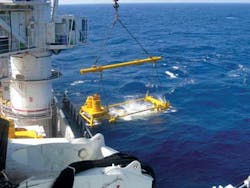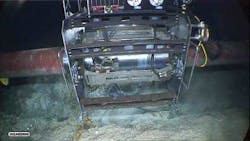Who would cut a perfectly good pipeline? Oceaneering worked with Shell to add a new tie-in for the Perdido oil export pipeline to the currently operating Hoover Offshore Oil Pipeline System (HOOPS) pipeline. This is the first time in deepwater operations anywhere in the world that a flowing pipeline without a pre-existing connection has been shut-in and re-configured to tie-in a new pipeline.
The installation took place as the result of the partnership between Shell’s design team and Oceaneering’s installation team. Contributing to the remarkable success story were Oceaneering’s high-technology Olympic Intervention IV support vessel, remotely operated vehicles (ROVs), ROV simulation capabilities, and a diverless installation team that worked in concert to achieve the desired results with only a short, 17-day interruption of downstream production of the HOOPS pipeline.
Tie-in Concept
The Perdido host facility operates in ultra-deep waters of the Alaminos Canyon Block 857 that had no production export infrastructure. The closest tie-in opportunity was at HOOPS, which extends from the ExxonMobil Hoover platform to Freeport, Texas. HOOPS did not have a connection link so it was necessary to perform the deepwater installation of a connection point to a working pipeline with minimal production shut in. Based on its experience with the repair of the Mars pipeline after Hurricane Katrina, Shell designed the hardware and a subsea process for the Perdido tie-in. Oceaneering facilitated Shell’s design feasibility using diverless intervention with ROVs.
Oceaneering’s scope for the tie-in consisted of fabricating and assembling the subsea hardware components, then performing system integration, operations planning, simulation, and subsea execution in 4500 fsw. Oceaneering’s Deepwater Technical Solutions (DTS) group developed many of the cleaning, clamping and cutting tools used in the Perdido operation.
Mission Simulation
Oceaneering used their onshore ROV simulator system to perform the preinstallation sequence. This process allowed the ROV pilots to become familiar with the tools they would be using and to practice installation procedures under true subsea conditions. Once the installation vessel mobilized, a portable ROV simulator system was used offshore on the job.
Olympic Intervention IV Vessel
The 312-ft Olympic Intervention IV subsea support vessel and crew performed the installation using built-in dual Millennium® Plus ROVs. The Olympic Intervention IV features a 150-mt active heave compensated crane that was used for overboarding the connection equipment. The vessel transmitted streaming video for real-time work observation by shore personnel during the job. The heave-compensated ROV launch and recovery system onboard the Olympic Intervention IV lowered the ROVs from the surface and transported the specialized tooling required for the job.
ROV Operation
The two separate ROV systems were staffed with multiple crews for 24-hour operations and were utilized for around-the-clock subsea work. The two systems usually worked together to complete the required tasks. In many cases, one ROV would perform the work while the second ROV directed the task from a better position near the worksite. High-definition cameras allowed the pilots to view the hardware in finer detail than possible with conventional filming technology.
Subsea Execution
The Perdido tie-in was accomplished using an innovative 70-ft long, 14-ft high, 50-ton foundation, which served as a structural support and work table that provided the means to align the pipeline connection. The foundation remains in place on the sea floor, where it can be used for future repair and maintenance operations.
Two lift frames were used to raise the 18-in pipeline about 3 ft off the seabed. Using winches and buoyancy gauged to 60,000 lb, Oceaneering’s crew pulled the foundation into place between the lift frames. With the foundation in place, Oceaneering used an ROV-operated Fusion Bond Epoxy (FBE) and weld seam removal tool to clean the existing HOOPS pipe and prepare it for connector installation. The pipeline was then sealed off locally on each side using isotope-embedded pigs. An ROV verified the pig locations before a 28-ft section of pipe was cut and removed. Spool assemblies were then landed onto the foundation, rolled into place and connected to the pipelines, leaving vertical hubs to re-connect the existing pipeline via a pre-fabricated jumper and an additional hub to connect the Perdido Oil Export pipeline.
Millennium® Plus ROV surveys the completed jumper installation and subsea tie-in at 4500 fsw.
Success Story with No Ending
The HOOPs tie-in is only one of Oceaneering’s success stories for Perdido and many other deepwater projects. Whenever or wherever there is a challenging subsea opportunity, Oceaneering is always available with its intervention expertise and experience.
OCEANEERING® and MILLENNIUM® are registered trademarks of Oceaneering International, Inc.
Oceaneering International, Inc.
11911 FM 529, Houston, Texas 77041 U.S.A.
Tel: +1 (713) 329-4568
Fax: +1 (713) 329-4951
Website: www.oceaneering.com







